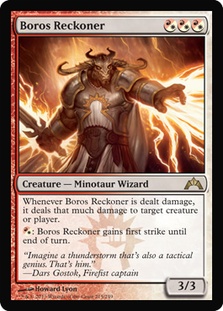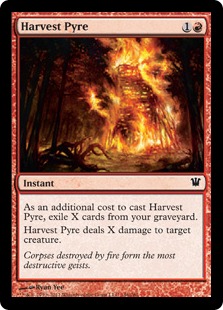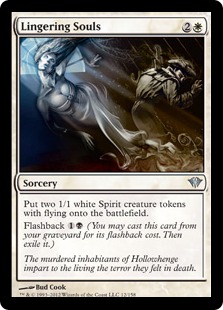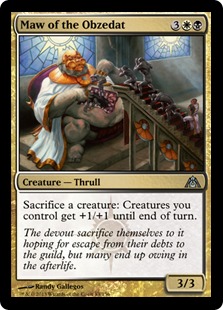It’s been a few weeks, hasn’t it? Well have no fear, because I have returned to save you from your day-to-day life. By now I assume that most of you expect me to be writing about some cool deck that I built or ran at FNM, as I have been doing that for almost a year now. When I first started writing for this wonderful website, I was 13 years old and in way over my head. I wasn’t great at the game, nor am I now.
When I was given this fantastic opportunity, though, I was excited. I knew it would not only get my name out there, but it would also give me an amazing way to get to know members of our community. People like Gerry Thompson and Sam Black were heroes to me inside the game, and writing gave me the opportunity to reasonably call them my friends after some time. Magic players from all over the world actually want to talk to me on Facebook, and I love having chats.
Publishing articles has also helped me improve my writing skills tremendously. I’m still nowhere near perfect, but I’m certainly much better than when I started. Steve Sadin, Lauren Lee, and now Cedric Phillips have all given me such amazing feedback, and I’m immensely happy to have people that are actively involved in making me a better writer. I’m only a sophomore in high school and have much more school ahead of me. The constant stream of writing that I have been doing has been invaluable to my education.
Why am I rambling like this? Well, it is in part because I want to let you know what amazing opportunities writing can provide. If you ever have the chance to start writing for a website, I would not think twice. You may be nervous at first, but even the trolls in the comments can help you become a better writer and player. The main reason I’m writing this is because I’m switching gears. I am a different player than I was when I first started writing. Two years ago I was the kind of person who loved rogue decks and swinging from outside of the box. As time went on, though, I started to enjoy rogue decks less and less. I started moving towards more mainstream decks and spending most of a Standard season learning a deck.
For example, I’ve been playing basically nothing but Jund Midrange in Standard for the past six months, and I plan to play it for as long as I can. Sticking with a real deck and learning its ins and outs have tremendously improved my tournament records. I’m not the kind of person who can pick up a deck and start playing it perfectly. I need to learn to play a deck from every angle before I can realistically start putting up results.
Like I said, I no longer enjoy rogue decks as much. As you may have noticed, my writing has been pretty sporadic lately. That is because I no longer have the passion for cool, new FNM decks. Not only that, but there are a couple new FNM style columns that have popped up on this very site, and frankly, I think they are better than mine at this point. If you haven’t read any of Matt Higgs articles or checked out [author name="Adam Prosak"]Adam Prosak’s[/author] new column, I highly recommend it. I plan to, at least for a while, abandon the FNM column and start something new.
I’m not exactly sure what I want to do yet, but if you have any ideas feel free to share them with me. I have to run a few ideas by Cedric, and I may do a few trial runs of assorted column ideas to see how they are received. One idea is a Standard gauntlet where I take a deck that I think is well placed in the metagame and run it against the major Standard decks at the time. The issue I see with this column is that my results may potentially be skewed by my lack of experience with a deck when I’m playing it.
For today, I’m just going to go over a few cool decklists I found on the What’s Happening page for Magic Online. That page is a very valuable resource for anyone trying to get an idea of what the current decklists look like and to get some new ideas. Standard right now is a pretty diverse format, and as such there is a lot of room for people to try new things. I found a few decklists that are either new altogether or are weird versions of existing archetypes. Either way, I definitely think that these decks have a chance with some tuning.
First up, we have a sweet brew courtesy of ihatepants!
Creatures (14)
Lands (23)
Spells (23)

Similar versions have been running around on Magic Online for a little while now, but this list looks pretty well tuned. The deck starts off with the typical package of Grisly Salvage, Mulch, Unburial Rites, Angel of Serenity, and Thragtusk. Sometimes with Reanimator, you cast a bunch of Mulches and Grisly Salvages but just keep hitting a bunch of lands and noncreature spells. You fill up your graveyard with a bunch of useless cards, and now you’re stuck waiting until turn 5 to even get any real action going.
What this deck lacks in quick mana dork acceleration it makes up for in a really awesome plan B. Instead of having a graveyard full of do-nothings, Harvest Pyre actually gives them a purpose. Pair it with Boros Reckoner and not only do you have a brick wall but you have an awesome win condition as well. This deck also plays Faithless Looting to fill up the graveyard and allow for quick reanimation and uses Farseek so it’s not without ramp. Lingering Souls is another trick out of the graveyard, and Sire of Insanity is a sweet card to both ramp out and reanimate against most decks.
Out of the sideboard, the deck looks to be bringing in a bunch of cards to smooth out the aggro matchups (Centaur Healer, Huntmaster of the Fells), especially the ones that can beat a Boros Reckoner—Sever the Bloodline as well as a couple good cards against control (Sin Collector) and Reanimator (Sever the Bloodline again). Overall, there’s not much I would actually change in this deck. I would consider trying to fit in Avacyn’s Pilgrim somewhere, but I imagine there is a reason that the deck has eschewed mana dorks.
Next up we have a list that has been tearing up Magic Online for a few weeks. My friend Sam Bucek ran a deck similar to this at #SCGNJ, and apparently Brad Nelson had also been working on a deck like it at the time. Anyway, here is the list:
Creatures (25)
- 4 Doomed Traveler
- 4 Young Wolf
- 4 Blood Artist
- 4 Cartel Aristocrat
- 3 Varolz, the Scar-Striped
- 4 Voice of Resurgence
- 2 Maw of the Obzedat
Planeswalkers (3)
Lands (24)
Spells (8)

Similar to The Aristocrats decks of old, this deck plays a reasonable clock backed up by removal for aggro and a slew of resilient creatures that hit hard against control. My friend Sam’s list was basically the same idea but without Maw of the Obzedat, and I tested a lot against it. Blood Artist really shines in the deck, as does Voice of Resurgence (but I guess he shines almost anywhere). Lingering Souls is also a very hard card to beat.
Maw of the Obzedat solves a lot of the problems that we saw in the initial lists. It gives you another sacrifice outlet, which I believe the deck wants, and it provides an amazing clock. With the right board (one that is not too hard to achieve in this deck), Maw of the Obzedat can help kill your opponent in one attack. Just like most Aristocrats variants, this deck is very resilient to Supreme Verdict since most creatures either regenerate, have undying, or will deal your opponent damage when they leave.
The sideboard has a lot of cards for the control matchup, as well as some niche cards against aggro. Deathrite Shaman gives you an awesome edge against Reanimator, and Unflinching Courage is a really interesting card that can deal large chunks of damage while keeping your life total high. This is another decklist that I’m not really sure what I’d do to. During testing, Sam and I really liked Obzedat, Ghost Council and Garruk Relentless. They had a lot of game against control and midrange and provided very fast clocks, which are things that this deck can occasionally be lacking.
Rounding out the decklists for tonight is a sweet Golgari midrange deck that a lot of people have been talking about. A very similar list did well at the StarCityGames.com Open Series in Nashville a few weeks ago in the hands of Robbie Cordell.
Creatures (14)
Planeswalkers (3)
Lands (25)
Spells (18)

A lot of the aggro decks are evolving to be more resilient to sweeper effects. Two major examples are the B/W/G Aristocrats deck above and the Naya Aggro deck that won the StarCityGames.com Standard Open in Dallas on Sunday piloted by Aaron Barich:
Creatures (28)
- 4 Strangleroot Geist
- 4 Dryad Militant
- 4 Loxodon Smiter
- 4 Experiment One
- 4 Ghor-Clan Rampager
- 4 Boros Reckoner
- 4 Voice of Resurgence
Lands (22)
Spells (10)
Sideboard

Instead of playing explosive but fragile creatures like Burning-Tree Emissary, they are playing slightly less explosive but much more resilient creatures like Strangleroot Geist and Voice of Resurgence. They are also playing one-card threats like Loxodon Smiter and Boros Reckoner. These cards need to be killed quickly, but one-for-oneing with Supreme Verdicts is really not what the control decks want to be doing. To combat this, a lot of players are moving to spot removal-heavy lists that still have game against the Burning-Tree Emissary decks.
Desecration Demon is a house in Standard right now. A 6/6 for four mana is tough for the aggro decks to punch through without sacrificing a creature, and it represents a very fast clock against control. Thragtusk is a pretty standard creature for green midrange decks, and Geralf’s Messenger serves a similar role to Desecration Demon. All of these creatures are walls against aggro that provide resilient or quick clocks against control.
Rounding out the creatures is a pair of Disciple of Bolas, which is this deck’s Sphinx’s Revelation. With Desecration Demon, you draw lots of cards and get a 2/1. With Thragtusk, you draw lots of cards and get a 3/3 with your 2/1. With Geralf’s Messenger, you draw three cards, gain three life, deal your opponent two damage, and get a 4/3 and a 2/1. That is quite the value!
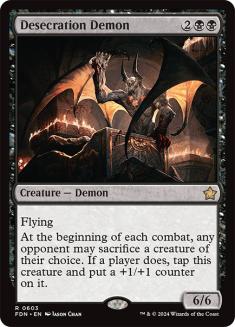

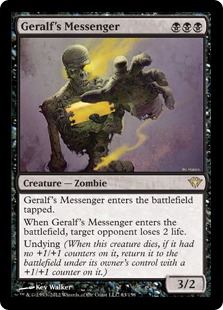
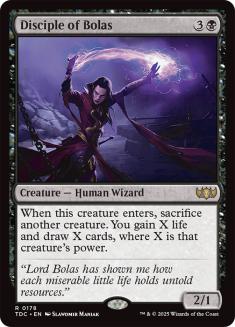
The deck uses spot removal as well as Mutilate for when you do need to clean up more than one creature. Sign in Blood is another draw spell that can occasionally kill your opponent, though I doubt it does that very often. Liliana of the Veil and Deadbridge Chant are awesome against control, and Liliana does double duty as a great card against Bant Hexproof, a matchup that is likely tough when you don’t draw Mutilate. Devour Flesh is also some redundancy in that department.
The mana base of this deck is pretty awesome because green is mostly just a splash—one which is easily supported thanks to Overgrown Tomb, Woodland Cemetery, and Golgari Guildgate while still maintaining more than enough Swamps for Mutilate. The sideboard mostly contains bullets for control and midrange decks as well as Deathrite Shamans for graveyard decks. Mutilate and Sever the Bloodline round out the sideboard for aggro and midrange decks. I think this deck is an awesome angle to attack the format from and may even give it a quick try on Magic Online when I get the chance.
Well, thanks for reading this week. While most of the article was just some rambling about my life, I still showed you some awesome decklists at the end. I am going to miss the FNM column, as I’ve been doing it for almost a year, but change is important. I can’t wait to get started on a new journey. Like I said, I’m not exactly sure what I want to do yet, so I’d love to hear if you guys have any cool ideas. I have had an absolute pleasure writing articles for the past two years, and I hope I can keep doing it for as long as possible. Thank you for reading, and I hope you join me on my new journey—whatever it may be!
AJ Kerrigan
@AJKerrigan55 on Twitter
[email protected]
PS. If you’ve sent me an email and I haven’t responded, I apologize. I’ve been having some issues with my email that I’m sorting out, so you should receive a response at some point. Thank you for your patience!

